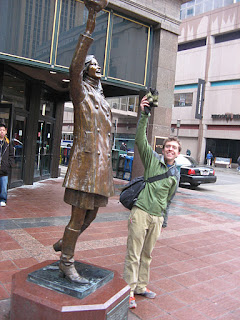From Renee in Bangladesh (who took the photo on the front):
 |
| Yes, this is the first postcard I've received from Bangladesh. Thanks, Renee! |
 |
| The "historic Minneapolis train bridge" is the Stone Arch Bridge, one of my favorite spots in the city. |
From ... I honestly don't know who, other than someone channeling Garrison Keillor while driving through Saint Peter, Minnesota (although the picture is of Denmark):
From Jane in New Zealand (who also sent me that delightful bear-o-gram a while back; the bear has settled in among the travel books on my shelves and seems quite content, although it does occasionally commandeer my computer to look up the latest news about the All-Blacks):
Brendon Ly is, I hereby decree, the coolest 15-year-old in Ottawa. He's the one who sent me the postcard from there a few weeks ago, the one beginning, "Hello, Stranger." When I opened his latest letter, this was the first thing I saw:
 |
| Crappy picture on my part, but you get the idea. |
A four-page letter. In old-style script writing. (Note at the top of the first page: "Pre-script: Usually I print.") Needless to say, no e-mail could possibly convey the same sense of personality and, well, charm as this letter, and even a high-resolution scan can't capture its nuances and details. Like the ink. As he notes on page three, "By the way, if you run a finger over the words, they will have a raised texture to them. I think this Chinese ink has shellac in it ... The thickness added by the shellac also helps it cling to dip pens, but will apparently clog up a fountain pen." Sure enough: it's raised. (NB: I had no idea fountain pens and dip pens were not the same thing. When I read that, I wanted to click over to Google to do some quick research--ignoring the rest of the letter for a sec, as I would have if it were an e-mail, only to return to it half an hour later after getting hopelessly distracted--but, this being a letter, I couldn't just move my mouse a few inches and click away. I couldn't be distracted. Score one more point for letters: they're more immersive.)
That blue pen you see above is a calligraphy pen, just to show off the differences in texture and stroke and style.
Finally, on the last page, the show-stopper. A hand-drawn illustration perfectly sized to make into a postcard. Included in the envelope was a piece of card stock with a the back already formatted.
"You know the rest," he says. "Send it to whomever you want to."
In other words, continue the cycle. Keep it going. Keep writing. Keep sharing. Not in the easy, mindless digital form--"sharing is caring," says all the 18-point Arial above a row of icons for FaceTwitPlusWhateverElseWasInventedYesterday. But in the more tangible, more physical, more personal sense. More texture, quite literally.
What a joy to get this letter--any letter, any postcard, of course, but especially this one.
And, yes, I will send the postcard on to someone else. Part of me wants to keep it for myself and not take scissors to paper. But that would defeat the entire point. A tear will trickle down my cheek as I release it into the mailbox, just like in those Disney films, the ones with the whales or the lions or the what-have-yous, and the benevolent caretakers who know the animals must be returned to the wild. Go free, young postcard! Venture forth! Godspeed! Find your place in the world!
Keep writing.
So. Thanks, correspondents! Much appreciated. My own stamp-affixed messages are already en route in some cases; the rest will be on the way in the next day or two--although, Brendon, it might take me a bit longer to come up with something to match your awesomeness.











































